Coronavirus Today: How to keep Halloween from becoming truly scary
- Share via
Good evening. I’m Karen Kaplan, and it’s Tuesday, Oct. 25. Here’s the latest on what’s happening with the coronavirus in California and beyond.
In Southern California, the entertainment capital of the world, Halloween is more than a chance to go door to door collecting candy. For the people who make a living doing makeup, creating costumes, building sets and pretending to be someone they’re not, the holiday is a chance to do all those things just for fun.
And this Halloween, they have a lot of pent-up party energy to get out of their systems now that pandemic precautions have eased.
“People are trying to make up for lost time,” Rick West, co-founder of the Halloween and horror convention known as Midsummer Scream, told my colleague Sonja Sharp. “We’re seeing that every event, every show, everything seems to be through the roof.”
The festivities have been months in the making. Haunted house aficionados began heading to Pierce College in Woodland Hills for Valley Fright Nights back in July. Disney’s California Adventure Park kicked off its Oogie Boogie Bash Halloween party in early September. (It sold out.)
You don’t have to be Disney to take Halloween seriously. Jesus Garcia is hoping to scare 2,000 visitors at his father’s home in Santa Ana, which he’s turning into a haunted house complete with a “horror maze” in the yard. The amateur production involves two dozen crew members, a homicidal jester, live cockroaches and a Satan on stilts.

Halloween is the unofficial start to the holiday season, and the last two times around, health officials were encouraging us to stick close to home and keep gatherings small.
They’re not saying that anymore.
“People should plan on being able to get together with the people that they love,” said none other than Los Angeles County Public Health Director Barbara Ferrer.
That’s especially true now, when most of the country — including every California county except Siskiyou along the Oregon border — has a low COVID community level, according to the Centers for Disease Control and Prevention.
(In fact, if you’ve recently resumed group activities that were put on hold when the pandemic began, my colleague Deborah Netburn would love to hear from you. You can share your coming-out-of-pandemic-isolation stories with her using this form.)
If you’re particularly susceptible to a severe case of COVID-19, or spend a lot of time with someone who is, you should think about taking extra precautions. Open windows and turn on the fan to keep the air circulating. Consider asking people to take a rapid coronavirus test before a gathering, and suggest high-quality masks for those who are most at risk.
I’m assuming you already know to get the new bivalent booster that’s specially designed to target the BA.5 strain of Omicron.
“We should all take advantage of the fact that we can be together with the people we love this holiday,” Ferrer said. But if we aren’t smart about it, COVID-19 deaths could rise again this winter, she added.
“However tired we may be of dealing with this shape-changing, mutating virus, I hope we can rally as a community and make every effort to protect our most vulnerable residents,” Ferrer said.
It may be tempting to write that off as the usual boilerplate warning from an overly cautious health official. But she’s not the only one who would like the public to stay focused on the continuing threat. Dr. Dipti S. Barot, a primary care doctor in the San Francisco Bay Area, reminds us that more than 2,500 Americans have died of COVID-19 over the past week.
“Some use the 9/11 unit of measure to reflect the scale of the tragedy. I prefer to think about all the kids I went to high school with, our teachers and the staff, and then imagine all those people disappeared out of those buildings, the quad, those hallways,” Barot writes in an Op-Ed. “This is the national weekly reaping that is our COVID response. The weekly empty high school, the weekly — insert your preferred unit of horror.”
Talk about haunting.
And if you prefer something more ghoulish, she offers this: “The only people for whom COVID is truly over are the thousands who die each week because of it.”
By the numbers
California cases and deaths as of 5:27 p.m. on Tuesday:

Track California’s coronavirus spread and vaccination efforts — including the latest numbers and how they break down — with our graphics.
Second-guessing Zoom school
You don’t have to get COVID-19 to be harmed by the pandemic.
The week isn’t even halfway over, and it’s already delivered two distressing reports about the academic impact of shutting down schools for the sake of public health.
Let’s start with the National Assessment of Educational Progress, also known as the “nation’s report card.” This standardized test was given to fourth- and eighth-graders in early 2022, and if it were an actual report card, an “F” would be too generous.
The test revealed that eighth-graders in almost every state and fourth-graders in well over half the states experienced significant drops in math performance compared with 2019. Scores for reading also fell in a majority of states, my colleague Paloma Esquivel reports.
Unfortunately, American students were struggling even before the coronavirus prompted schools to shut their doors and pivot to online learning. In 2019, about one in three eighth-graders were considered proficient in math; by 2022, that ratio had dropped to about one in four.
“The data prior to the pandemic did not reflect an education system that was on the right track,” said U.S. Education Secretary Miguel Cardona. “The pandemic simply made it worse. It took poor performance and dropped it down even further.”
He called the test results “heartbreaking and it’s horrible.”
Things are so bad that only half of teachers surveyed in conjunction with the test said they were “quite” or “extremely” confident in their ability to help students make up their pandemic-related learning gaps.
In a rare display of equity, states across the political and demographic spectrum saw their students’ performance erode during the pandemic. However, that will make it hard for experts to tease out the relationship (if any) between the length of pandemic-related closures and the deterioration of students’ performance.
But wait, there’s more.
A few hours later, California officials released their own testing results, and the results were similarly distressing.
Statewide, two-thirds of students who took the Smarter Balanced assessment this spring failed to meet math standards for their grade level, and more than half fell short of English standards, including writing, listening and research skills. The tests were administered to students in Grades 3 through 8, as well as to high school juniors.
The results were bad for students across the board, but they were especially bad for historically underserved students, Esquivel and Howard Blume report.
For math, 84% of Black students and 79% of Latino students didn’t meet state standards this year. Neither did 52% of white students and 31% of Asian students. For English, 70% of Black students and 64% of Latino students fell short, along with 39% of white students and 25% of Asian students. (If you’d like to see detailed results by grade level and/or demographic category, you can find them here.)
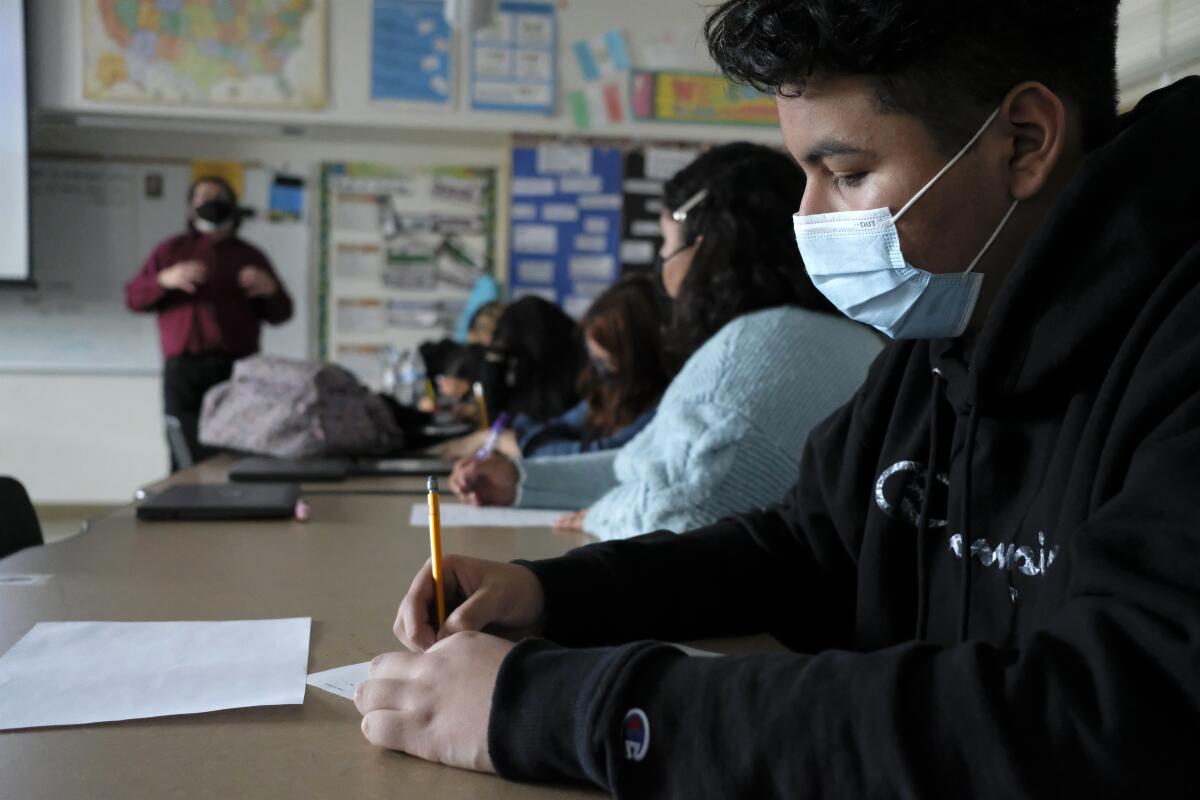
“We had these wide gaps that weren’t closing before the pandemic and now it’s just worse,” said Li Cai, an education expert at UCLA. “The important point is what do we do about it?”
Tony Thurmond, the state superintendent of public instruction, said Sacramento was recruiting 10,000 more school counselors, providing $250 million to boost literacy, and investing $4 billion in “community schools” that would serve students’ needs beyond education, among other initiatives. But he also reminded the public to consider the post-pandemic test scores in a broader context.
“It’s fair for people to be concerned about the experience that kids have had,” Thurmond said. “But we also had 99,000 Californians who lost their lives to COVID. And we did the things that we felt we needed to do to save lives.”
He has a point. Not only has COVID-19 killed more than 1 million people in the U.S., but it’s also deprived more than 200,000 children of at least one of their parents.
Still, as the scope of pandemic learning loss becomes more evident, some parents and educators are second-guessing the extended campus closures of 2020 and 2021. There are third-graders still trying to get the hang of reading, and high schoolers who’ve given up on school because they think they’ll never catch up.
By summer of 2020, scientists understood that kids were much less vulnerable to COVID-19 than adults. That winter, studies showed that if students and teachers took precautions like wearing masks and practicing social distancing, schools wouldn’t fuel coronavirus spread in their communities. Still, many schools in California and elsewhere stuck with Zoom school until well into the spring of 2021.
Research by Brown University economist Emily Oster found that students who spent most of the 2020-2021 school year online got lower test scores than their counterparts who attended class mostly in person. The gap was 8 percentage points in reading and 13 percentage points in math.
Knowing what he knows now, “I can’t imagine a situation where we would close schools again, unless there’s a virus attacking kids,” said Eric Conti, superintendent for Burlington, Mass.
Many parents feel the same way.
Marla Williams, a single parent in Chicago, was initially in favor of distance learning, especially since she and her two children suffer from asthma. She recruited her father, a retired teacher, to help out. But it wasn’t enough to keep her son engaged. He stopped doing assignments until he was able to return to campus on a hybrid schedule in the spring of 2021.
“I wish we’d been in-person earlier,” Williams said. “Other schools seemed to be doing it successfully.”
California’s vaccination progress
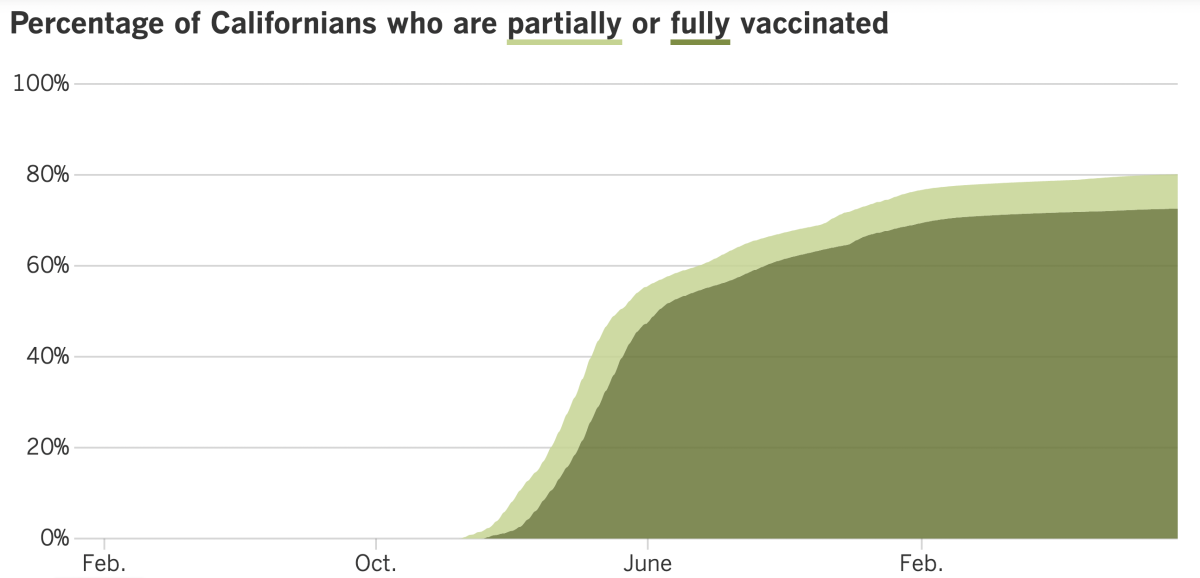
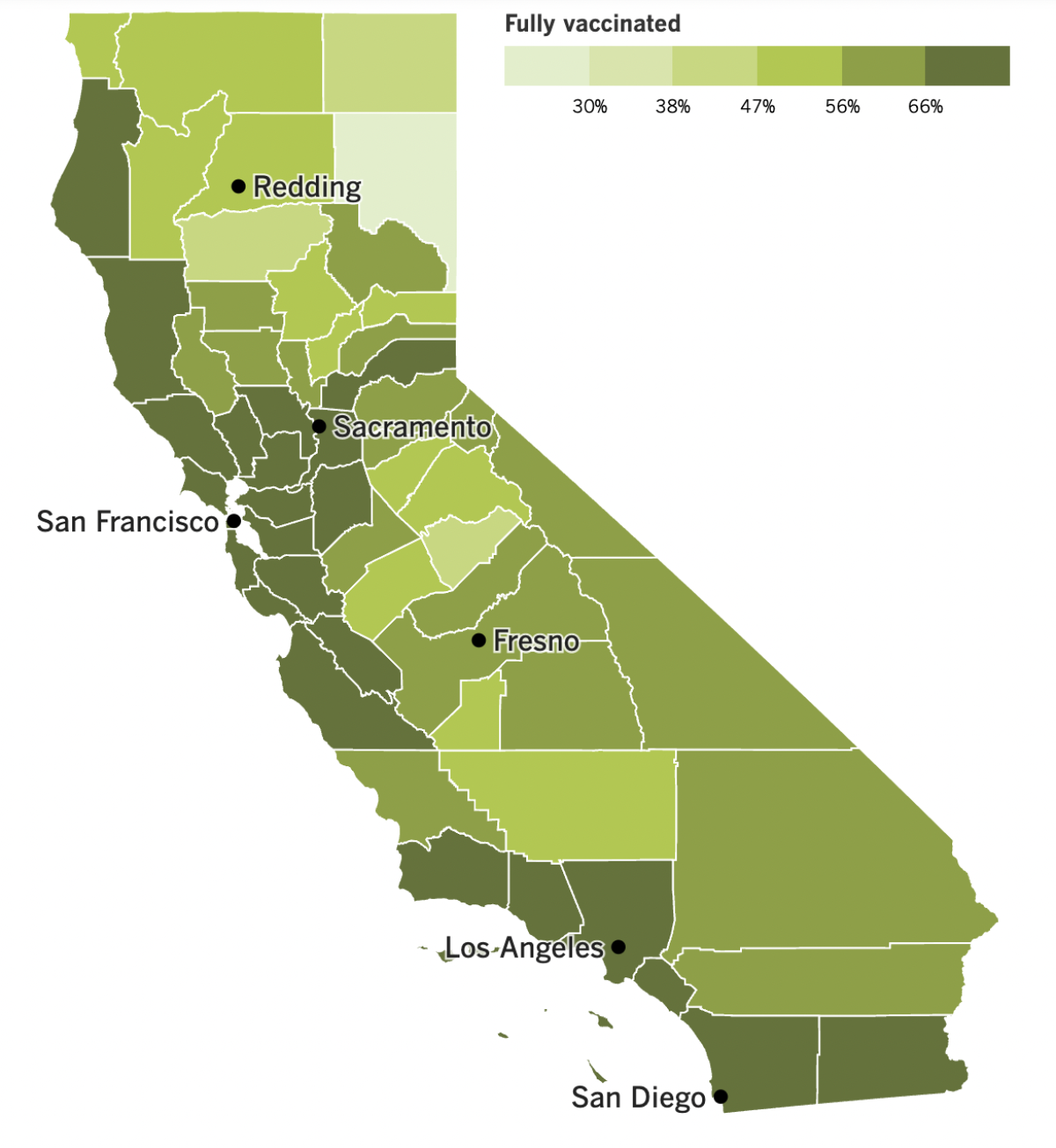
See the latest on California’s vaccination progress with our tracker.
Your support helps us deliver the news that matters most.
In other news ...
Let’s start with some good news: By one measure, the hypercontagious Omicron subvariant known as BA.5 is loosening its grip on California and the rest of the country.
The strain once accounted for an estimated 86.6% of coronavirus specimens in circulation nationwide. After weeks of steady declines, that figure is now 62.2%, according to the Centers for Disease Control and Prevention. In California, BA.5’s share has dropped from 92% in mid-August to about 80% now, the California Department of Public Health calculates.
But this pandemic is rife with caveats, so here’s the bad news: That retreat is leaving room for other variants to flourish, and they could cause even more trouble than BA.5 has.
A potentially problematic subvariant known as BQ.1.1 has filled some of the void; it rose from around 0.2% of specimens in mid-September to 7.2% now. A related contender known as BQ.1 went from 0.5% to 9.4% of specimens during the same period. Both are descendants of BA.5.
For the moment, they’re still scarce in Los Angeles County. As of late last week, officials had documented seven infections caused by BQ.1 and three caused by BQ.1.1.
But those numbers may not stay low for long. The rise of new subvariants has coincided with the end of a weeks-long decline in new cases both in L.A. County and in the San Francisco Bay Area. It’s not yet clear whether the new strains are responsible.
Health officials love to tell us the best way to keep case numbers from rising is to get vaccinated and boosted. As of Wednesday, the COVID-19 vaccine made by Novavax may be a new option for your booster.
The Novavax shot has been available as a primary two-dose series since the summer. It’s made without mRNA, which was expected to be a selling point among COVID vaccine holdouts. Yet fewer than 40,000 doses have been administered nationwide, according to CDC data.
It’s bound to be even less popular as a booster. The Food and Drug Administration authorized it only for adults who’ve never had a booster before and who can’t take one of the new bivalent boosters for medical or accessibility reasons — or who would otherwise skip their booster altogether.
In other vaccine news, a CDC advisory panel has voted to add COVID-19 shots to the list of recommended shots for both kids and adults. That shouldn’t come as any great surprise — after all, the panel has already endorsed the shots for all Americans over the age of 6 months. But symbolically, it would place them on an equal footing with vaccines for diseases like polio, measles and hepatitis.
The action by the Advisory Committee on Immunization Practices caused Fox News host Tucker Carlson to freak out about the prospect of COVID-19 vaccines becoming “mandatory for kids to attend school.” His rant was unnecessary because vaccination requirements for schools are set by state and local authorities, not the CDC.
The CDC “only makes recommendations for use of vaccines, while school-entry vaccination requirements are determined by state or local jurisdictions,” explained Kate Grusich, a spokesperson for the agency.
Rather than chill out, Carlson accused the CDC of “lying” and repeated his false claims. Health law experts sided with the CDC.
The U.S. isn’t the only country struggling to boost its vaccination rate. Only eight countries in Africa have gotten more than half their populations fully vaccinated against COVID-19, according to the World Health Organization.
Liberia, Mauritius and Seychelles have surpassed the 70% benchmark, and Rwanda is expected to join them soon. Four other countries have hit the 50% mark.
The average for the continent as a whole stands at 24%, the WHO said. (For the sake of comparison, the worldwide average is 64%.) And although vaccines are becoming easier to find, the number of doses administered is now less than half what it was three months ago.
This isn’t just an Africa problem, it’s a global problem, said Dr. Matshidiso Moeti, the WHO regional director for Africa.
“The end of the COVID-19 pandemic is within sight,” she said, “but as long as Africa lags far behind the rest of the world in reaching widespread protection, there is a dangerous gap which the virus can exploit to come roaring back.”
And finally, if Dr. Anthony Fauci can get COVID-19, anyone can — including the director of the CDC.
Dr. Rochelle Walensky tested positive on Friday night and was experiencing mild symptoms, the agency said, adding that she was up to date with her booster shots.
Your questions answered
Today’s question comes from readers who want to know: Can I find out which coronavirus strain made me sick?
Not easily.
The tests that are used to determine whether someone has an active infection can’t distinguish among different coronavirus strains. That goes for laboratory PCR tests as well as the rapid antigen tests you can take at home.
“No, it is not possible to for people to find out which variant caused their infection as a diagnostic test,” according to a spokesperson for the L.A. County Department of Public Health.
The California Department of Public Health suggests checking its online COVID Assessment Tool to see the prevalence of different variants throughout the state. (Click on “COVID,” then click on “Variants.”) The BA.5 subvariant of Omicron currently accounts for an estimated 80.4% of the SARS-CoV-2 coronaviruses in circulation, so if you have an infection right now, odds are that’s the strain that caused it.
That’s as much information as you’re likely to get.
The CDPH and the CDC have surveillance systems in place that include genetic sequencing of some specimens sent to labs for diagnostic testing. In California, “this information is gathered for public health purposes and is not returned to [doctors] or an individual patient,” according to a spokesperson for the state public health department.
If you have a burning desire to know which version of the coronavirus sickened you, you could ask your doctor to enlist the help of a specialized lab. But a healthcare provider would only agree if the information would make a difference in your treatment, the CDPH said.
We want to hear from you. Email us your coronavirus questions, and we’ll do our best to answer them. Wondering if your question’s already been answered? Check out our archive here.
The pandemic in pictures
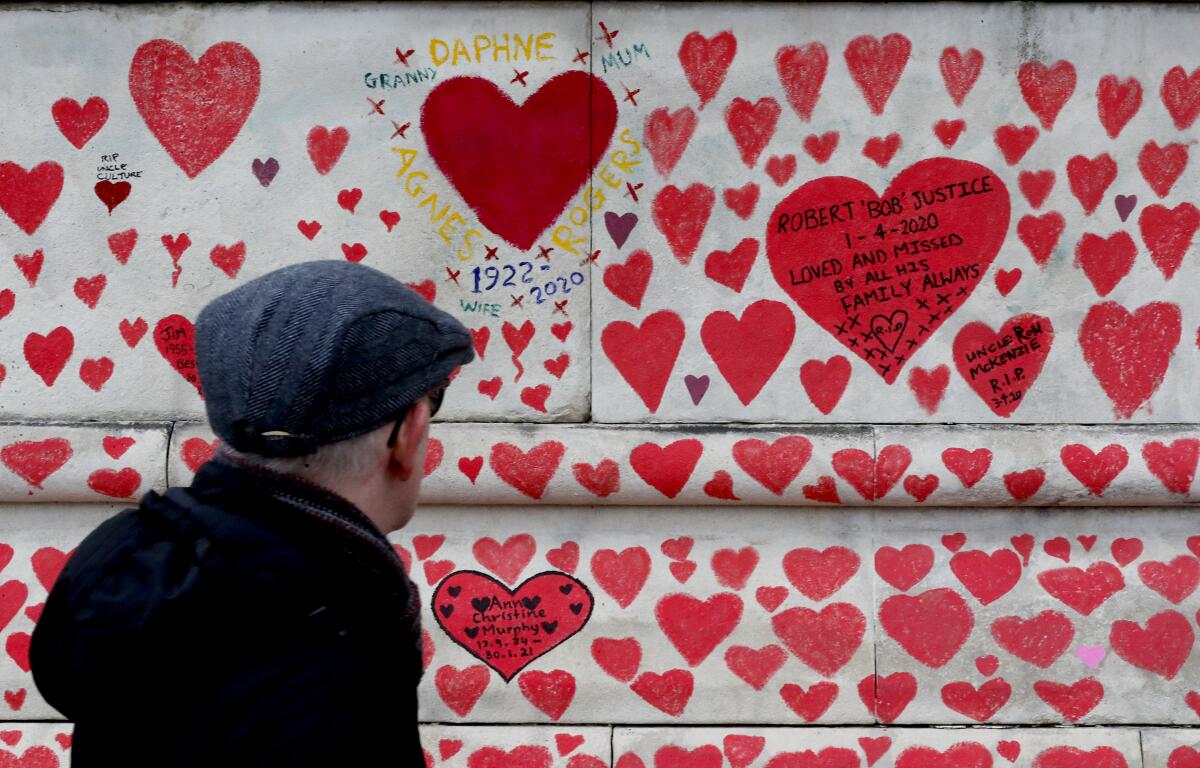
The man in the photo above is standing in front of the National COVID Memorial Wall in London. The memorial stretches for about a third of a mile along the stone embankment on the south side of the River Thames, and it’s adorned with more than 150,000 hearts. Each hand-painted heart represents a person in the United Kingdom who died in the pandemic.
The memorial wall was established by the COVID-19 Bereaved Families for Justice (a group that pressed for a public inquiry into why the United Kingdom suffered such heavy losses) and Led by Donkeys (a political organization and vocal critic of the government’s handling of the pandemic). Volunteers painted the hearts in March 2021, and they’ve been touched up since to keep them looking sharp.
Many of the hearts have personalized inscriptions. But it’s the sheer number of them that conveys the magnitude of the country’s grief.
If you can’t go see it in person, you can take a virtual tour online at memorial wall’s website. As your fingers scroll along, you’ll hear moving stories about some of the people whose names are enshrined in the hearts.
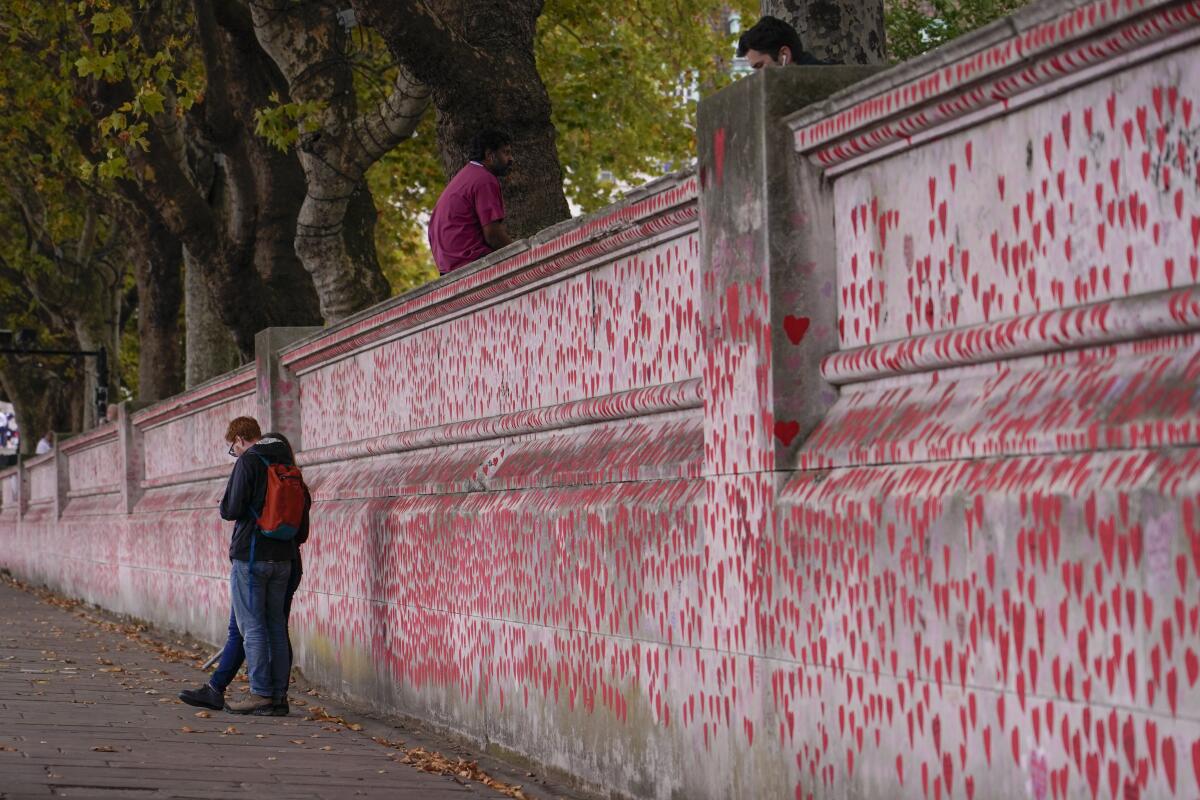
Resources
Need a vaccine? Here’s where to go: City of Los Angeles | Los Angeles County | Kern County | Orange County | Riverside County | San Bernardino County | San Diego County | San Luis Obispo County | Santa Barbara County | Ventura County
Practice social distancing using these tips, and wear a mask or two.
Watch for symptoms such as fever, cough, shortness of breath, chills, shaking with chills, muscle pain, headache, sore throat and loss of taste or smell. Here’s what to look for and when.
Need to get a test? Testing in California is free, and you can find a site online or call (833) 422-4255.
Americans are hurting in various ways. We have advice for helping kids cope, as well as resources for people experiencing domestic abuse.
We’ve answered hundreds of readers’ questions. Explore them in our archive here.
For our most up-to-date coverage, visit our homepage and our Health section, get our breaking news alerts, and follow us on Twitter and Instagram.




